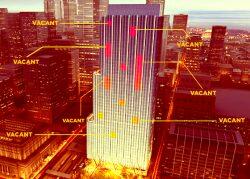Chicago’s office market is getting even more bifurcated, as downsizing tenants seek out newer amenity-rich buildings such as the BMO Tower in the West Loop and the redeveloped Old Post Office and shun older spaces in the Central Loop.
That’s the conclusion from second-quarter reports from commercial brokers JLL, MBRE and Newmark. Class A and trophy offices accounted for 90 percent of new leases in the second quarter, JLL found, as business concentrated in what JLL broker Todd Mintz called the “deal triangle” encompassing the West Loop from the Post Office, Fulton Market and the southern edge of River North to Wolf Point and Merchandise Mart.
“When tenants are making a move and making a decision, it’s clear the type of building they’re moving to,” Mintz told The Real Deal. “They’re moving to a building that has abundant amenities and is commute-worthy and really creates an experience for an employee when they come into the office.”
The lackluster market and workers’ laggard return to office compared with other major cities has led landlords to put renewed focus on retaining tenants. The tenants, in turn, have been trying to change the size of their leases more frequently than ever to accommodate hybrid work schedules preferred by many employees.
All that adds up to 6.3 million square feet of sublease space on the market in the central business district, topping an all-time high set earlier this year, according to MBRE. Direct vacancy also remains stubbornly high, just below the last quarter’s record, at 19 percent, as older unrenovated buildings empty, according to JLL. So far this year, tenants have shed a net 1 million square feet, Newmark said.
The problem is that offices sought by tenants in a post-pandemic world emphasize common areas for employees far more than before Covid, when firms focused on having enough space for desks for workers to perform so-called heads-down tasks. After landlords designed offices based on that model, much of that sort of work is now being done from home offices.
“In the past, it was a ratio of 70 percent desks space to 30 percent meeting room and collaboration areas, and now that’s swapping,” said Benedikt Köppel, founder of Switzerland-based Locatee, a firm that tracks the use of commercial buildings in Europe and the U.S. Locatee says meeting and collaboration spaces are being used far more than individual desks, a trend that has picked up since the pandemic slowed this spring.
Mintz expects demand to tick upward for the Central Loop as a low-cost alternative to Chicago’s newest developments. If rapid absorption continues for trophy assets, it will leave tenants with little other choice than to consider some of the Loop’s older assets, some of which — such as the Thompson Center building that’s been said to be a potential target for Google to purchase — are going through pricey renovations that could close the gulf between them and Fulton Market.
Further dampening demand, the brokerages noted the pandemic isn’t over as new mutations prompt concern from public health experts, and the potential of a recession weighed on consumers.
“All of this means the office market will remain volatile, with tenants remaining uncertain about the future,” Newmark’s report said.
Read more



